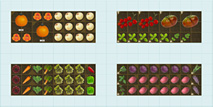Basics
- Ease of Growing
- Easy
- Grown as
- Annual
- Days to Maturity
- 75-90 (Spring/Summer), 60-90 (Fall/Winter)
- Growing Habit
- -
- Hardiness
- Half Hardy
Sunflowers will tolerate light frost.
- Crops
- Spring Transplant, Spring, Summer
- Growing Season
- Long
- Cultivar Type
- -
- Growing Conditions
- Warm, Hot
Sunflowers needs rich soil for good growth. They prefer full sun (though they will tolerate light shade). The taller varieties need shelter from the wind and should be placed where they won't cast unwanted shade on other plants.
- Outdoor Growing Temp
- 55°F - 95°F
- Min Outdoor Soil Temp
- 50°F
Don't plant out until the soil is at least 50˚ F (and preferably 60˚ F).
- Start Indoors
- Yes
- Start Outdoors
- Yes
- Light
- Sun: min. 6 hours daily (Warm, Hot)
Full sun.
- Water
- Moderate
Sunflowers are thirsty plants and for maximum production they need a constant supply of water.
- Feeder
- Heavy
Low nitrogen. High phosphorus. High potassium. Sunflowers like phosphorus and potassium, but not too much nitrogen as it may encourage leaf growth rather than flowering.
- Suitability
- High heat, Needs lots of space
- Small Gardens?
- No
- Containers?
- No-
- Attracts beneficial insects?
- Yes
- Color
- Cinnamon-bronze
- Fruit Size
- 5.0 - 6.0"
- Plant Height
- 60.0 - 84.0"
- Plant Diameter
- 12.0 - 18.0"
- Good Companions
- Melon, Cucumber
- Bad Companions
- Bean
- Hardiness Zone
- 3-10
- Disease Resistance
- -
- Taste Profile
- -
- Rotation Group
- Flowers

